I posted this here: http://www.yachtforums.com/forums/yacht-crews/10048-my-life-monaco.html#post65529
I have memories of my time based in Monte Carlo as a Steward on board Milamba IV, a 108 foot steel displacement Feadship with a very British (Campers and Nicholson refit) style and British crew.
 In 1979 I had hitch-hiked to the South of France after dreaming of someday working on a luxury yacht. I was 18 at the time and the 6 months I was there has since become quite a fantasia of memories, from serving Robert Mitchum dinner (he really was very tall) to having the smart Italian men on board for lunch off the Islands on Cannes. Most of the visitors were extremely secretive, some I recognise now as heavy-weight industrialists on the TV, in those days they just flexing their young muscles.
In 1979 I had hitch-hiked to the South of France after dreaming of someday working on a luxury yacht. I was 18 at the time and the 6 months I was there has since become quite a fantasia of memories, from serving Robert Mitchum dinner (he really was very tall) to having the smart Italian men on board for lunch off the Islands on Cannes. Most of the visitors were extremely secretive, some I recognise now as heavy-weight industrialists on the TV, in those days they just flexing their young muscles.
John Ryan was my Boss, he was the last Chief Steward of Queen Mary (yes, the first Queen Mary!). We had a Canadian Capt and his younger brother John, our engineer. Gary, a former Royal Navy diver was our deckhand with Peter dropping in as a Chauffeur / spare deckhand. A Glaswegian, Grant was our chef. All in all, for an ex Public School preppie like me, it was completely normal. Crew quarters were cramped with three small twin cabins and tiny mess; U shaped dinette and combined lounge facing a massive row of freezers huddled up in the bow. We had enough food to last most people a lifetime. The Captain had his own cabin near the bridge.
When we were at port, my job started at about 6:30 in the morning with a cup of coffee and a Marlboro whilst hanging out the side door of the galley bathing in the morning sun. Once dressed in smart white trousers and yacht-branded T-Shirt, I would start the brass polishing, dusting and vacuum cleaning. We had a lot of brass, particularly the banister rail from the owner’s cabin to the saloon. On a number of occasions, I would put the Brasso on and forget to polish it off! The Boss wasn’t happy.
During breakfast, I dashed into the cabins and made the beds and cleaned the bathrooms. This could be a busy day if we had guests and I would sometimes negotiate with them as to the best time to do their cleaning. The best answer was of course, “don’t bother”!
After breakfast, Ryan and I would clear away and I’d wash up. If we were in Monaco (our home port), at around 10:30 fresh flowers would arrive. I would spend time with “Madam” to put them out. I had a bit of a crush on her. She was quite young and really nice and pretty!
Often we had lunch visitors so I might go into the market with Grant mid-morning to get some fresh food in. He used me as his “mule” and would load me up with lots of bags. He always insisted on shopping in full chef whites, branded accordingly with our yacht name etc. I was very proud of him as the sellers would insist that Grant come to the front to the queue and the locals would all stop and watch us. Grant would be offered free samples of fruit or maybe some fish. He would nod accordingly and then promptly order in his deep Scottish accent. He couldn’t speak French at all and it was extremely funny watching him negotiate for quantities. He would complain to me when the conversation would stall and he would be left wondering what he’d ordered! At least I could speak some of the local lingo!
Nearer lunchtime, I’d help him as he rushed about preparing some exotic meal. During this slack period, I often became his kitchen porter, changing out of my white T Shirt and donning an apron to wash his horrid pots!
 At lunch, Ryan would normally ban me from entering the saloon whilst the visitors arrived and mingled. Sometimes, he forgot and I would help until he ushered me out. He liked the limelight I think and didn’t want me cramping his style. From the galley, I would hear the guests laughing. Sometimes, he would bark at me to follow in behind him with crisps and nuts etc, but mostly he had me as back-up on stand-by outside the galley. Often, Ryan and I would just stood to, outside the galley, our ears alert to the sound of the tinkling. Finally, Grant would indicate that he was ready to serve. Ryan would give me a little smile, he would calm right down and say, “regardless of the pandemonium we’ve been through this last 90 minutes, now we must be Lords and walk in with our heads high and our standards at the same level. Are you ready?” It always amused me when he told me to act like a Lord since I always they were drunk, however I knew what he meant!
At lunch, Ryan would normally ban me from entering the saloon whilst the visitors arrived and mingled. Sometimes, he forgot and I would help until he ushered me out. He liked the limelight I think and didn’t want me cramping his style. From the galley, I would hear the guests laughing. Sometimes, he would bark at me to follow in behind him with crisps and nuts etc, but mostly he had me as back-up on stand-by outside the galley. Often, Ryan and I would just stood to, outside the galley, our ears alert to the sound of the tinkling. Finally, Grant would indicate that he was ready to serve. Ryan would give me a little smile, he would calm right down and say, “regardless of the pandemonium we’ve been through this last 90 minutes, now we must be Lords and walk in with our heads high and our standards at the same level. Are you ready?” It always amused me when he told me to act like a Lord since I always they were drunk, however I knew what he meant!
The guests would marvel at me being so polished and young (I looked about 14!). I remember the Boss telling me to serve him from the “wrong side” once because of the extra visitors we’d had that day, I couldn’t get past to get to his left. The entourage chuckled with him at my predicament. Of course, eventually they’d all disappear drunk into the afternoon sky and the Boss would go down for his 2 hour sleep and calm would descend.
Afternoons were often very peaceful. As crew, we were allowed to sunbathe on the bow amongst the anchor chains etc. Sometimes I would wander off to the bar in the town, overlooking all the yachts and sit there sipping a Coke, marvelling at my very strange life. Of course, some afternoons were very busy and we’d be dragging our anchor (and everyone else’s!) off the bottom of Monte Carlo harbour just to pop out for a couple of hours of show-off time. Sometimes, “Madam” would have a friend on board and I could hear them giggling when they pressed the button for me to turn up on the boat deck. They found it very amusing to order drinks and snacks off me and they’d giggle when I turned up. Once, her girlfriend (I think her old “best friend” from school who came visiting for a few days when the Boss was away) intentionally let her bikini-top slip down and they both howled with laughter, slightly tipsy. Of course, being so young, I pretended that life was completely normal like this.
Every Friday afternoon, we sailed to St Tropez and parked stern-in right opposite the Gorilla bar (La Gorille?) making a huge show for the holidaying public. We would be on best behaviour, throwing our ropes and fenders about to best effect. Madam would be calmly sitting on the aft deck with Mr Boss whilst we put the best show on town on. The crowd would marvel at our skill. We became “family” for half an hour for the benefit of our egos and the Boss’s approval before going back to our normal bickering selves.
Mostly, Peter will have followed us to St Tropez in the Boss’s beautiful mahogany twin Chrysler V8 Riva powerboat. I adored that boat with its cream leather seating and vast engine cover to lie down on when it was whooshing along. On Saturday afternoon, we would usher the Boss and Madam to one of the beaches using our Zodiac as a kind of backup. We would act like MI6, delivering our cargo to the richest beach in the world, leaving a crew behind with walkie-talkies to stay in contact with Mother-ship!
On Saturday nights, we’d take turns in keeping one crew on board whilst the rest went to the bars in “civvies”. The Boss and Co normally went off to their friends’ houses or local restaurants. They didn’t go out for late nights, arriving back by 11:00pm. I was always extremely courteous to my Boss and when it was my turn to “baby-sit” him, I would try and make him laugh. I was after all, very happy that he’d given me my dream job. Normally he ordered freezing cold Vodka or sometimes a hot chocolate. I was always happy to get him what he wanted. Once, recognising my keenness to make him happy, he pulled a wad out and gave me a 100 franc note. He swore me to secrecy not to tell a sole that he’d given it to me, not wanting any backlash from the other crew I guess.
In mid-summer, we sailed to Venice, a three week trip which we all really enjoyed, weaving through the Greek islands. The crew laughed their socks off at me when the Captain told me to get on the boat deck and push the huge electric cables over the top of the radar mast with the wooden boat hook as we went under the cables strung between Italy and Sicily at the Messina Straights, “You won’t get electrocuted Callum!”. Of course, as we came closer, they went above the boat by around 500 feet or so. I felt a real dumb-ass. When I climbed back down into the bridge, Madam had obviously been let in on the secret and gave me a Mummyish smile (woops, that crush is coming back!).
That night, we were given a bit of leave and we headed into Messina to have a drink. 30 years ago, of course Messina would have had a fair amount of organised individuals, controlling trade and luckily for me, if you are an innocent working for a Boss who was happy to stop at Messina to meet his friends, my wallet and passport were very safe. In the morning, they were still lying on the same table I had left them on the night before. Friends in high places indeed.
The Greek islands are beautiful and we stopped at some amazing places including Kos. The harbour was so small, we only just got in, turned around and docked by the main wall (if only we’d had had digital cameras in those days). Work on board was extremely light whilst cruising. Little dust meant less work for me and the days were spent lazying around on the foredeck, waiting for that little bell to tinkle. At least we all spread the load. Poor Gary spent one day chipping, the next day red leading and the next day applying fresh new white paint. Rust, red and white. I’m sure it wasn’t that bad, but that’s all I remember him doing on that cruise. Cleary the trip from Southampton to the Med had started the rusting process. Perhaps it should have been shot-blasted or something during the refit the year before?
Venice was marvellous. The Captain explained that if we got up very early, we would be arriving as the sun was coming up. Sure enough, watching the radar screen, I could see the channel ahead and finally, opposite from the famous St Marco square, we parked our toy ship between 4 massive anchor stations; these are those wooden structures that apparently are full of bats. This was 30 years ago so maybe times have changed, but health and safety was certainly not on the agenda then. John, Gary and I had lots of fun taking our lines to them in the Zodiac and they made me climb up onto them to slip the line through. As I did that, a load of bats would fly out. Ugh. I was screaming and the crew were laughing. I was such a girl back then.
 It was in Venice that Robert Mitchum and his wife came for dinner. A most polite and graceful man, even though he was huge – really huge. Those original Hollywood stars really were amazing guys. For some reason he knew my Boss really well and they hugged when he came aboard. A load of TWA execs also came for dinner and they all speculated about Howard Hughes and wondered if he really had died. Clearly Howard couldn’t have been dead long than and it was still hot news. Mr Mitchum shook my hand when he left and thanked me for a pleasant dinner. His hands were the size of dinner plates. The only other time I was so affected by another man was Sir Ranulph Fiennes, who thanked me once when I bought his book. It’s like he looked right into my soul with his huge blue eyes. Just like Mr Mitchum did all those years ago.
It was in Venice that Robert Mitchum and his wife came for dinner. A most polite and graceful man, even though he was huge – really huge. Those original Hollywood stars really were amazing guys. For some reason he knew my Boss really well and they hugged when he came aboard. A load of TWA execs also came for dinner and they all speculated about Howard Hughes and wondered if he really had died. Clearly Howard couldn’t have been dead long than and it was still hot news. Mr Mitchum shook my hand when he left and thanked me for a pleasant dinner. His hands were the size of dinner plates. The only other time I was so affected by another man was Sir Ranulph Fiennes, who thanked me once when I bought his book. It’s like he looked right into my soul with his huge blue eyes. Just like Mr Mitchum did all those years ago.
The Boss and Madam flew back to London from Venice telling us they’d meet us in Nice in a fortnight. We were to have a holiday. We filled with fuel, a 110 tons of diesel apparently, which took hours from a local fuel barge. Why tons and not gallons or litres I wonder..? It was just as well that we filled up since we hit a calamity of a storm coming down the Adriatic. The boat was tossed about like a 10 foot dingy. The Captain was so hell bent on getting back to have a holiday that we were 45 degrees to the waves and the stabilisers could only do half a job most of the time – they were wings, not stabilisers and we clattered over to 45 degree rolls. Only the tons of fuel deep in our belly kept us upright. The twin screws were rattling their bearings dry on many crests. Thankfully I was completely unaware of the dangers. I’ll bet we dumped some diesel through those Caterpiller engines though since we were at Sardinia within a couple of days anchored off a lovely beach. We did some skiing off the back of the Zodiac and some Scuba too. Gary and I shared a single tank and sat on the bottom at 30 feet, looking up at the hull in a crystal clear sea making the OK sign at each other. Great fun. Gary liked to think he was teaching me to be a Royal Navy diver I think!
In the evenings, we took the Zodiac to the port and of course, in the best traditions of sailors, got completely hammered on the local booze.
After the Venice trip, a thorough bout of depression hit us via an anti-climax, only the news of a mini-trip to Nice to pick the Boss up sparked us into reality. I remember a flat calm, perishingly hot day with the quiet hum of our twin Caterpillers driving us ever forward with me, sitting astride the chrome bow sprit, looking down at the bow wave. Mindless days. We were pleased to see them when we met on the dock, and he us. A family again.
The end of the summer was looming and yacht crews were busy swapping jobs. Gary was excited about a promotion to another boat that we’d often bump into in St Tropez. John and his brother, the Captain were staying on as was the brown-nosed Peter. Clearly Ryan was at the end of his career and was stuck to the Boss like glue while Grant I believe, wanted to go back to Glasgow. Our lives crossed like ships in the night. I often wonder what happened to them all.
In early September, we started getting the boat ready for the Caribbean, an Atlantic crossing. Apparently a Lloyds crew were going to sail the boat there for Christmas. Of interest, I was offered a full-time job either on the boat or back in London looking after their Mayfair apartment, however I had had the taste of the high life and wanted part of it. I couldn’t do that working as a servant.
I have dreams of being back there working on the boat (we called it the boat when we worked on her). More recently I actually dreamt that I had discovered her rusting away in a Liverpool dock and I bought her for £125,000 UKP. Typing these memories, I thought I’d do another Google search and found a 2005 advert for her. I’ve saved the pictures. She’s had a flying bridge added which I think ruins her very 50’s style (although of course, a 1970’s yacht) and now called Lady Andrea.
Anyway, I trust you’ve enjoyed this little ditty from 30 years ago, it’s been rather pleasant writing them down. Apologies if I’ve rambled on a bit.
Cheers and beers.
Callum.
 If you have never heard about the Kef 104/2 (104-2) loud speakers, you have missed a life-time treat. I am lucky enough to have the gold plated, bi-wired version. In fact, I had the factory make these for me in the mid-90s, nearly three years after production ended since I missed mine so much. They really are the last pair of 104/2s ever made. Kef upgraded all the components for me and made me brand new Rosewood shells from new veneer. Fabulous looking.
If you have never heard about the Kef 104/2 (104-2) loud speakers, you have missed a life-time treat. I am lucky enough to have the gold plated, bi-wired version. In fact, I had the factory make these for me in the mid-90s, nearly three years after production ended since I missed mine so much. They really are the last pair of 104/2s ever made. Kef upgraded all the components for me and made me brand new Rosewood shells from new veneer. Fabulous looking.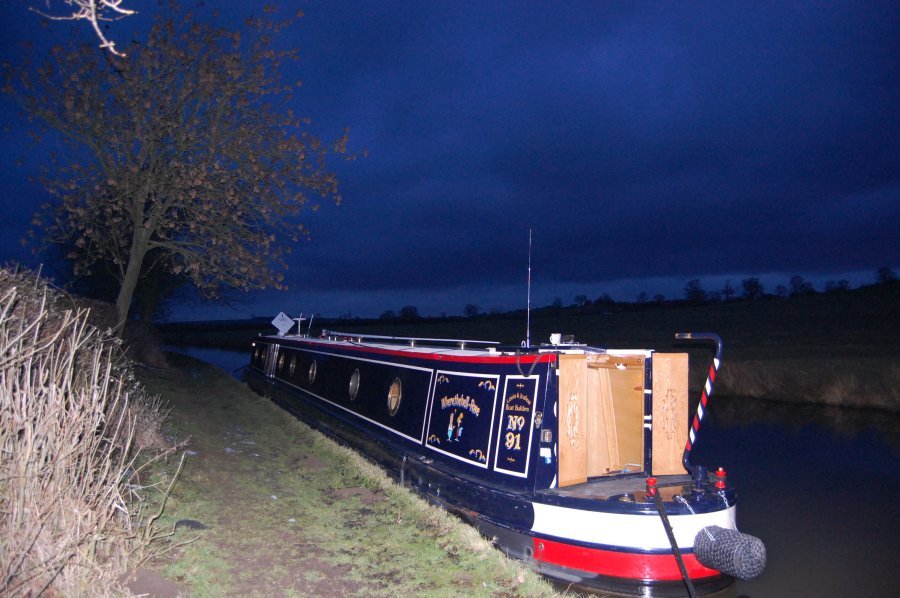 This trip was all about discovering the North Oxford canal via Braunston. Family rules dictate that we were to turn around when we get bored – which we did pretty quickly because there’s nothing to see up the North Oxford! We did a U turn on the morning of Day 2 and spent a pleasant 6 hours cruising back to Braunston, booking a table for 4 at the Old Plough.
This trip was all about discovering the North Oxford canal via Braunston. Family rules dictate that we were to turn around when we get bored – which we did pretty quickly because there’s nothing to see up the North Oxford! We did a U turn on the morning of Day 2 and spent a pleasant 6 hours cruising back to Braunston, booking a table for 4 at the Old Plough.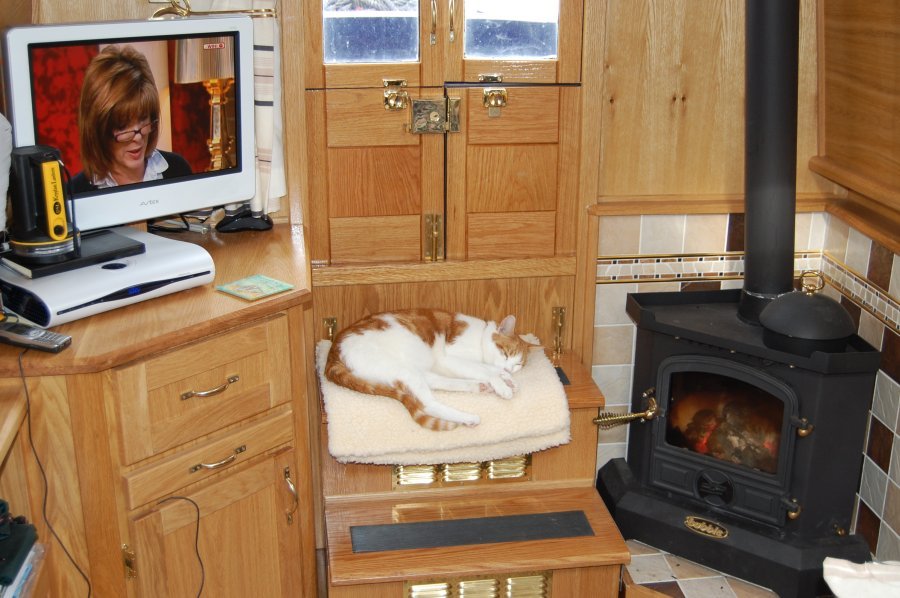
 I like to keep my eye on my old host, Milamba IV, since renamed to Lady Andrea.
I like to keep my eye on my old host, Milamba IV, since renamed to Lady Andrea. It turns out (and I didn’t know this) that:
It turns out (and I didn’t know this) that:













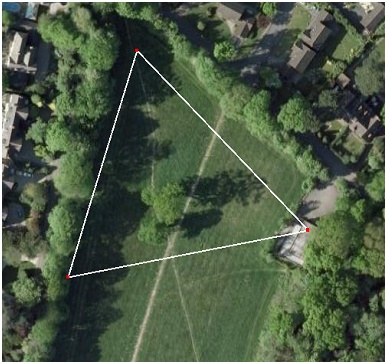 The Mega-Loop is working superbly at the Scout hut, although I’m trying to find something better for 160m. The impedance is already slightly low on top band and with a 4:1 balun in line at the feedpoint, it seems throws the SWR out by quite a bit. The ACOM 2000 seems to handle such a mis-match, in fact, it only trips out with a return power equating to around 575 watts. Technically, does this means that I can fire 1,000 watts up the coax and have nearly 600 watts come back to me? I don’t know – and certainly not above 1,850 anyway (UK band plans & license conditions etc). I’ll need to check.
The Mega-Loop is working superbly at the Scout hut, although I’m trying to find something better for 160m. The impedance is already slightly low on top band and with a 4:1 balun in line at the feedpoint, it seems throws the SWR out by quite a bit. The ACOM 2000 seems to handle such a mis-match, in fact, it only trips out with a return power equating to around 575 watts. Technically, does this means that I can fire 1,000 watts up the coax and have nearly 600 watts come back to me? I don’t know – and certainly not above 1,850 anyway (UK band plans & license conditions etc). I’ll need to check.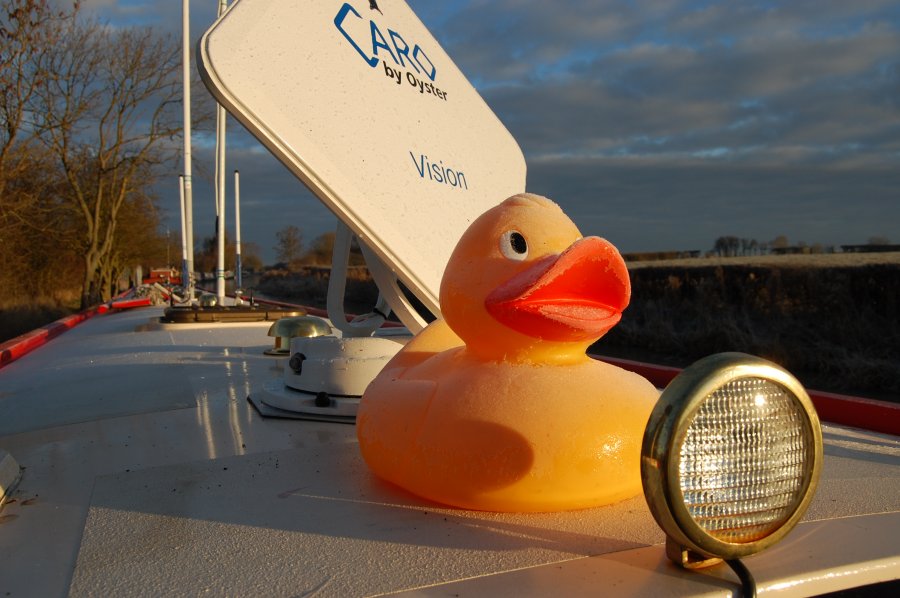 This weekend, we took the boat out for the first time as a family since the summer. Each time we have previously tried to take the boat out, we seem to have hit various mechanical snags and had to return home. This time it was the weather that nearly pushed us home. However my long lost genetics of the Outer Hebrides encouraged me to continue.
This weekend, we took the boat out for the first time as a family since the summer. Each time we have previously tried to take the boat out, we seem to have hit various mechanical snags and had to return home. This time it was the weather that nearly pushed us home. However my long lost genetics of the Outer Hebrides encouraged me to continue.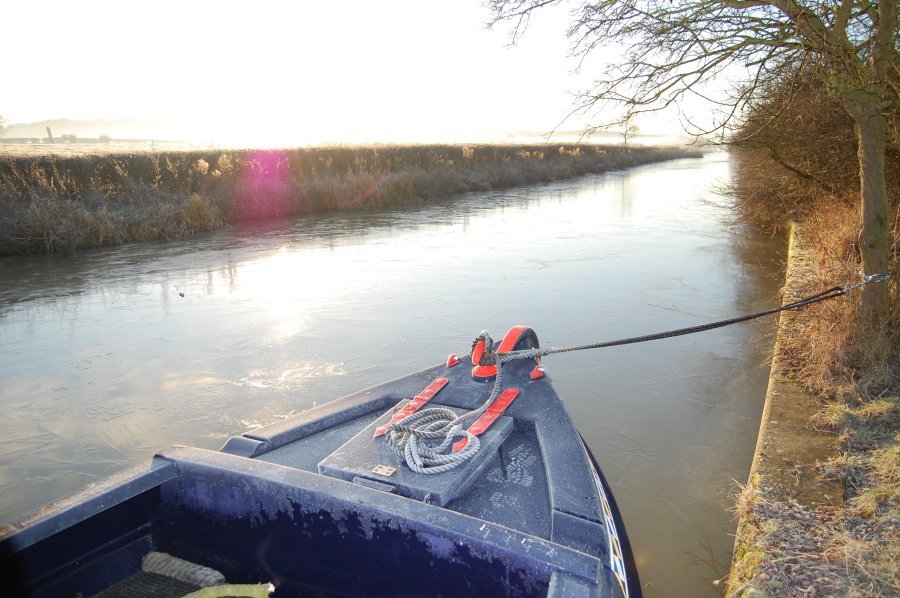 Nearly an inch of ice had formed on the canal surface during the night which surprised me. I didn’t think it could form that fast. It certainly made a bloody racket though. Everytime you moved, it would scrape and groan on the hull.
Nearly an inch of ice had formed on the canal surface during the night which surprised me. I didn’t think it could form that fast. It certainly made a bloody racket though. Everytime you moved, it would scrape and groan on the hull.
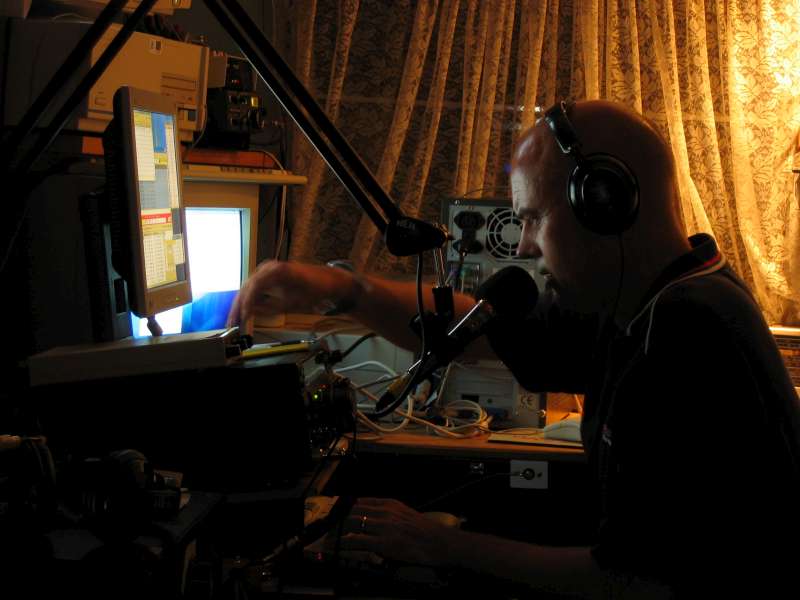
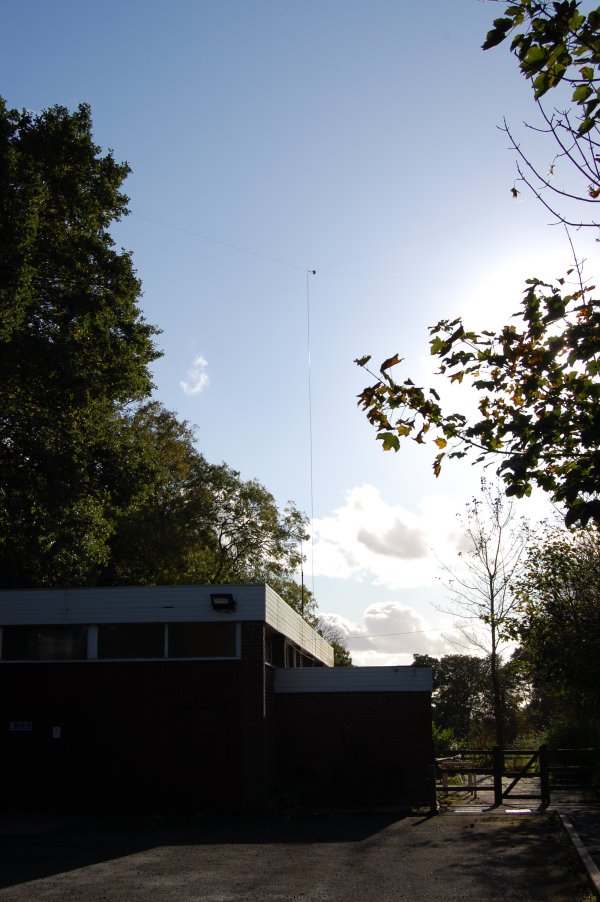 107 in the log. I’ve no idea what my score was since I used N1MM’s DX Serial Contest template to do the logging and the miscellaneous field for logging random text did a hopeless job of being able to edit long club names efficiently.
107 in the log. I’ve no idea what my score was since I used N1MM’s DX Serial Contest template to do the logging and the miscellaneous field for logging random text did a hopeless job of being able to edit long club names efficiently.









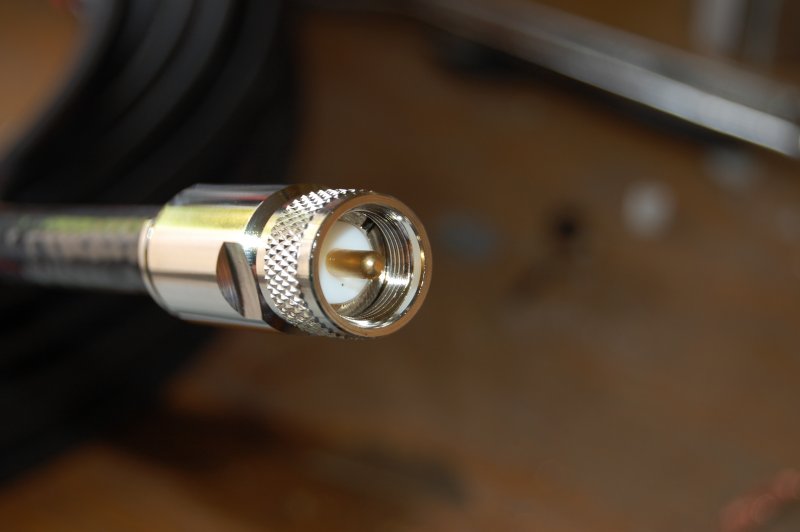 I’ve been lucky enough to purchase 100 meters of Ecoflex 15 recently and the solderless connectors are awesome.
I’ve been lucky enough to purchase 100 meters of Ecoflex 15 recently and the solderless connectors are awesome. Massive success this year with the new antenna, generating huge pile-ups world-wide. We shall never go near 80m again for JOTA. 20m is the band that synchronises extremely well with passing Scouting messages around the world, particularly if you have a technically proficient station and crew.
Massive success this year with the new antenna, generating huge pile-ups world-wide. We shall never go near 80m again for JOTA. 20m is the band that synchronises extremely well with passing Scouting messages around the world, particularly if you have a technically proficient station and crew. RF was via one of our FT1000MP radios and amplified by an ACOM. A pair of Dell PCs running N1MM did the logging. We networked the PCs for disaster recovery purposes and used the second copy of N1MM on the spare PC a couple of times when RF shut down the run machine. We were Multi-Single.
RF was via one of our FT1000MP radios and amplified by an ACOM. A pair of Dell PCs running N1MM did the logging. We networked the PCs for disaster recovery purposes and used the second copy of N1MM on the spare PC a couple of times when RF shut down the run machine. We were Multi-Single.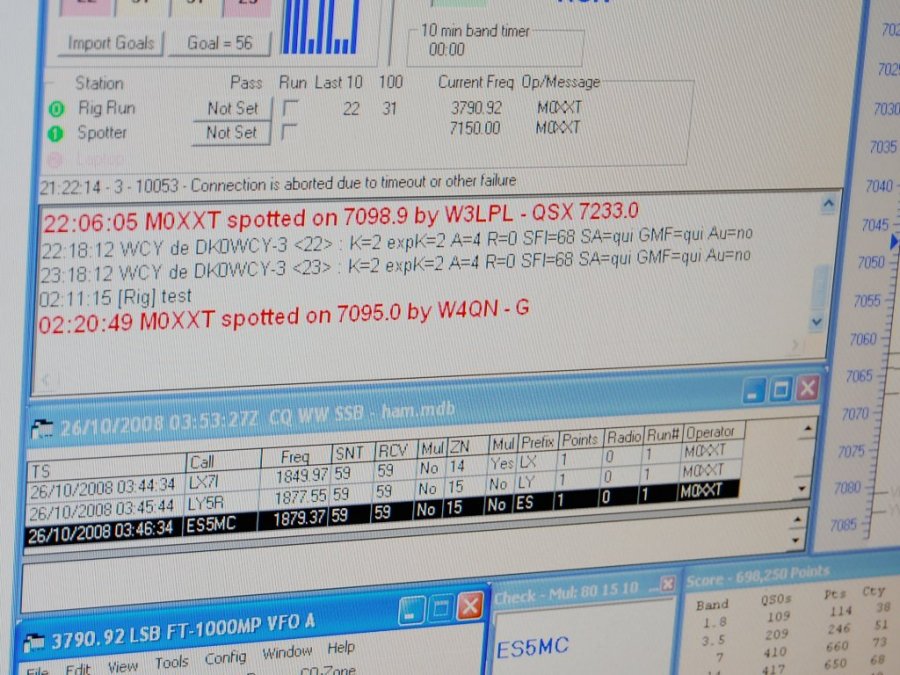 I personally had a couple of exceptional highlights that I’ll remember for a while. The first was on Saturday evening, running a split to the US on 40m and getting a pile up for my money. The rate meter peaked at 230 which I thought was pretty darned good. At one point, I burst out laughing with a mixture of adrenaline rush and terror! I have never had a high-gain antenna to the US and just didn’t think that it was possible to have so many people calling you! Getting spotted by W3LPL made it worse (or better..!!).
I personally had a couple of exceptional highlights that I’ll remember for a while. The first was on Saturday evening, running a split to the US on 40m and getting a pile up for my money. The rate meter peaked at 230 which I thought was pretty darned good. At one point, I burst out laughing with a mixture of adrenaline rush and terror! I have never had a high-gain antenna to the US and just didn’t think that it was possible to have so many people calling you! Getting spotted by W3LPL made it worse (or better..!!).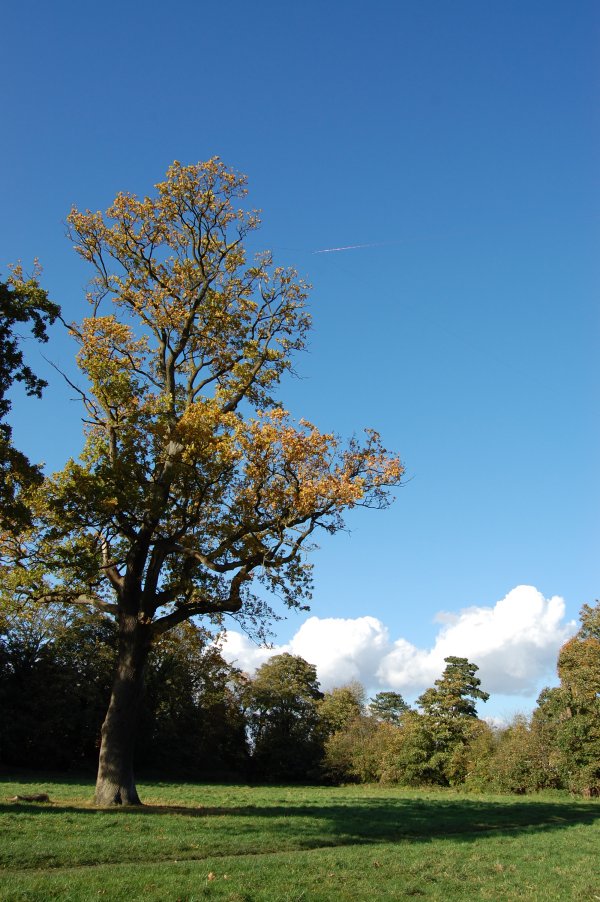 Saturday / Sunday saw us tear down the minutely designed and executed 28.5m leg triangle and on the spur of the moment, we put one up twice the size. It only JUST fits at 57 meters each leg, and again this is a perfect triangle. At 20m in height, we should have experienced nearly 15dBi towards North America and sure enough we ran a string of US stations all Saturday and Sunday scoring on both days into California with signal reports in the 57s and 58s. Exceptional. But these lobes don’t just work into US, we worked Ethiopia, Brunei, Bermuda, VK9, the list goes on and on. This is a serious loop and great fun for running on – it’s also nearly invisible!
Saturday / Sunday saw us tear down the minutely designed and executed 28.5m leg triangle and on the spur of the moment, we put one up twice the size. It only JUST fits at 57 meters each leg, and again this is a perfect triangle. At 20m in height, we should have experienced nearly 15dBi towards North America and sure enough we ran a string of US stations all Saturday and Sunday scoring on both days into California with signal reports in the 57s and 58s. Exceptional. But these lobes don’t just work into US, we worked Ethiopia, Brunei, Bermuda, VK9, the list goes on and on. This is a serious loop and great fun for running on – it’s also nearly invisible!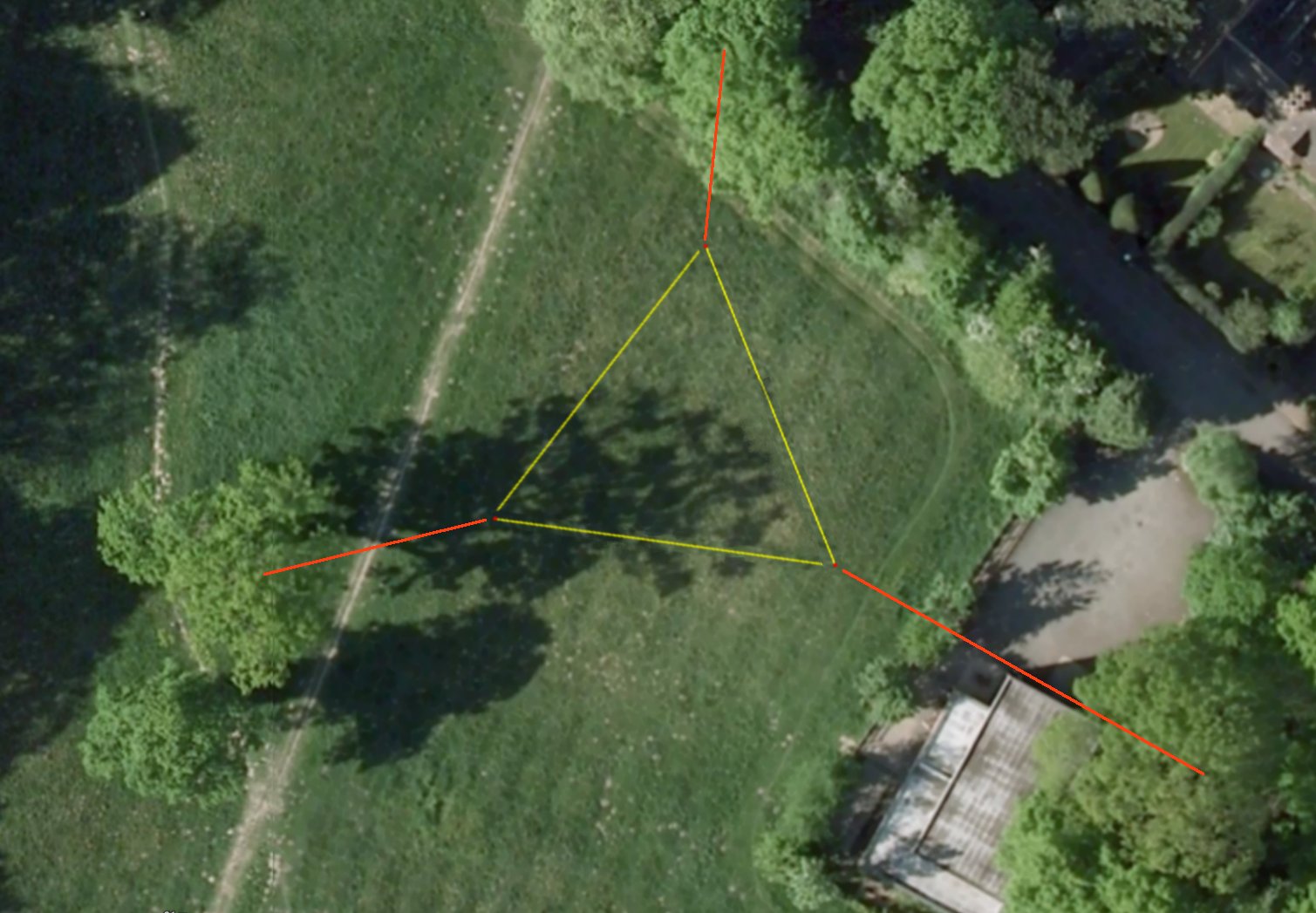
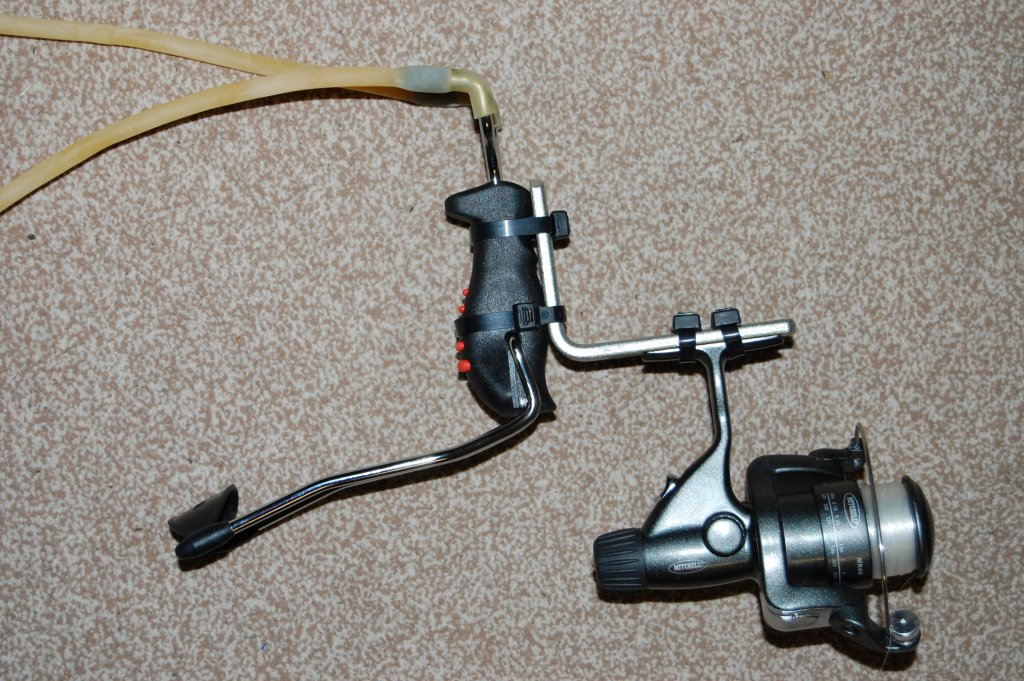
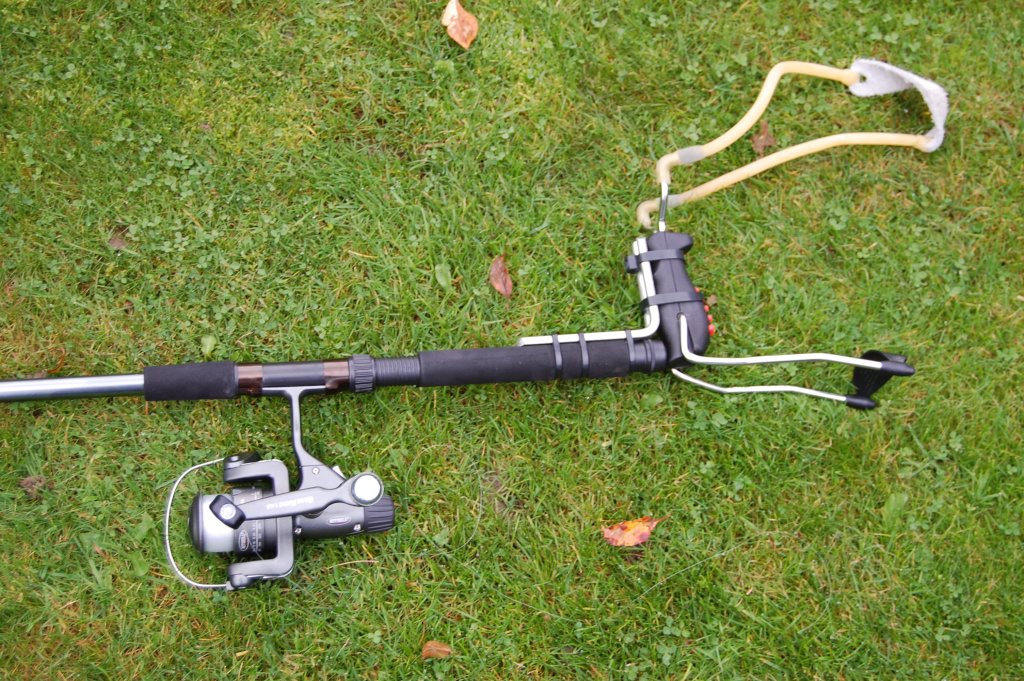
 At lunch, Ryan would normally ban me from entering the saloon whilst the visitors arrived and mingled. Sometimes, he forgot and I would help until he ushered me out. He liked the limelight I think and didn’t want me cramping his style. From the galley, I would hear the guests laughing. Sometimes, he would bark at me to follow in behind him with crisps and nuts etc, but mostly he had me as back-up on stand-by outside the galley. Often, Ryan and I would just stood to, outside the galley, our ears alert to the sound of the tinkling. Finally, Grant would indicate that he was ready to serve. Ryan would give me a little smile, he would calm right down and say, “regardless of the pandemonium we’ve been through this last 90 minutes, now we must be Lords and walk in with our heads high and our standards at the same level. Are you ready?” It always amused me when he told me to act like a Lord since I always they were drunk, however I knew what he meant!
At lunch, Ryan would normally ban me from entering the saloon whilst the visitors arrived and mingled. Sometimes, he forgot and I would help until he ushered me out. He liked the limelight I think and didn’t want me cramping his style. From the galley, I would hear the guests laughing. Sometimes, he would bark at me to follow in behind him with crisps and nuts etc, but mostly he had me as back-up on stand-by outside the galley. Often, Ryan and I would just stood to, outside the galley, our ears alert to the sound of the tinkling. Finally, Grant would indicate that he was ready to serve. Ryan would give me a little smile, he would calm right down and say, “regardless of the pandemonium we’ve been through this last 90 minutes, now we must be Lords and walk in with our heads high and our standards at the same level. Are you ready?” It always amused me when he told me to act like a Lord since I always they were drunk, however I knew what he meant! It was in Venice that Robert Mitchum and his wife came for dinner. A most polite and graceful man, even though he was huge – really huge. Those original Hollywood stars really were amazing guys. For some reason he knew my Boss really well and they hugged when he came aboard. A load of TWA execs also came for dinner and they all speculated about Howard Hughes and wondered if he really had died. Clearly Howard couldn’t have been dead long than and it was still hot news. Mr Mitchum shook my hand when he left and thanked me for a pleasant dinner. His hands were the size of dinner plates. The only other time I was so affected by another man was Sir Ranulph Fiennes, who thanked me once when I bought his book. It’s like he looked right into my soul with his huge blue eyes. Just like Mr Mitchum did all those years ago.
It was in Venice that Robert Mitchum and his wife came for dinner. A most polite and graceful man, even though he was huge – really huge. Those original Hollywood stars really were amazing guys. For some reason he knew my Boss really well and they hugged when he came aboard. A load of TWA execs also came for dinner and they all speculated about Howard Hughes and wondered if he really had died. Clearly Howard couldn’t have been dead long than and it was still hot news. Mr Mitchum shook my hand when he left and thanked me for a pleasant dinner. His hands were the size of dinner plates. The only other time I was so affected by another man was Sir Ranulph Fiennes, who thanked me once when I bought his book. It’s like he looked right into my soul with his huge blue eyes. Just like Mr Mitchum did all those years ago.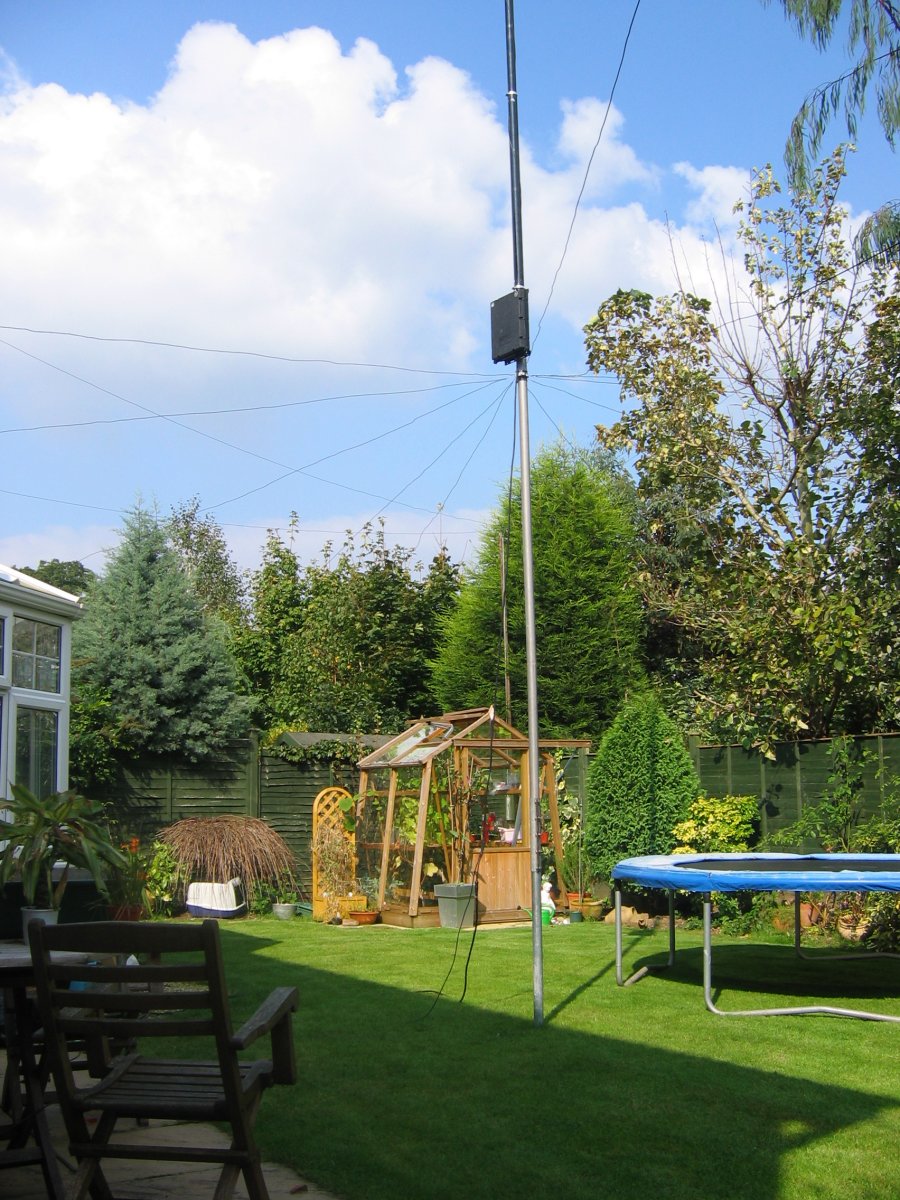














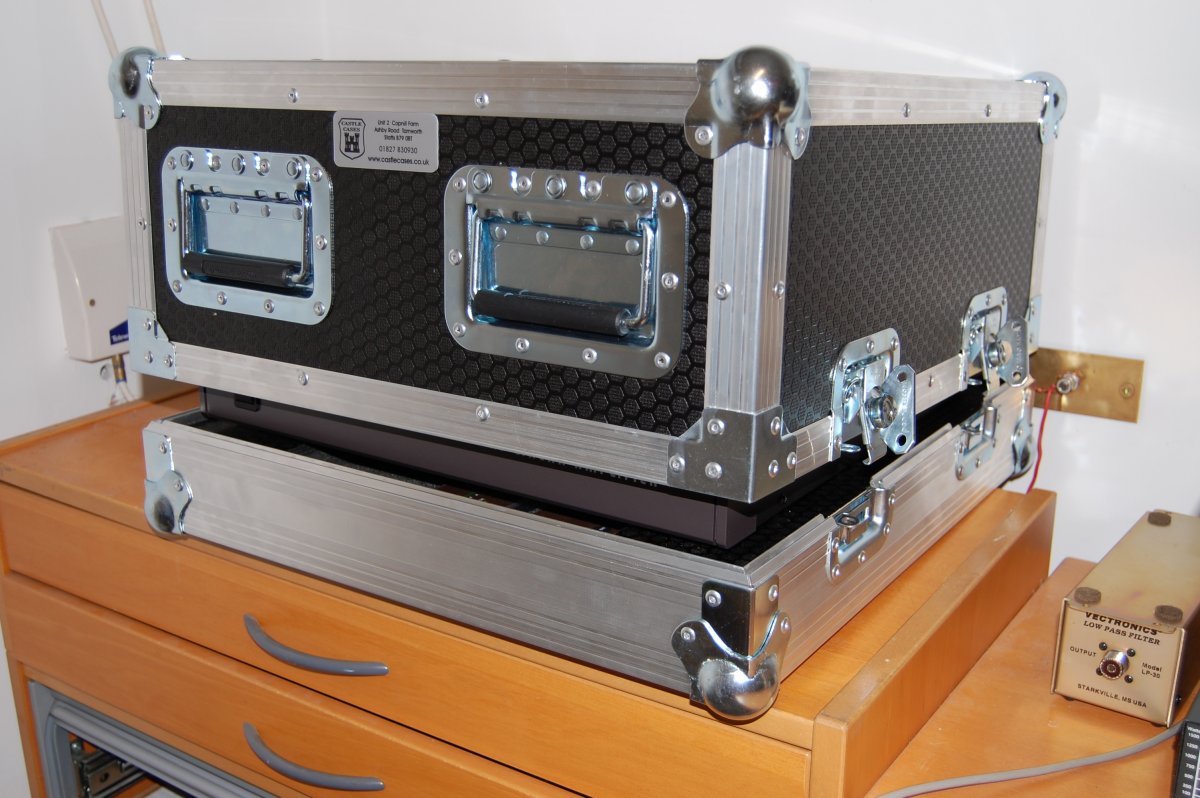
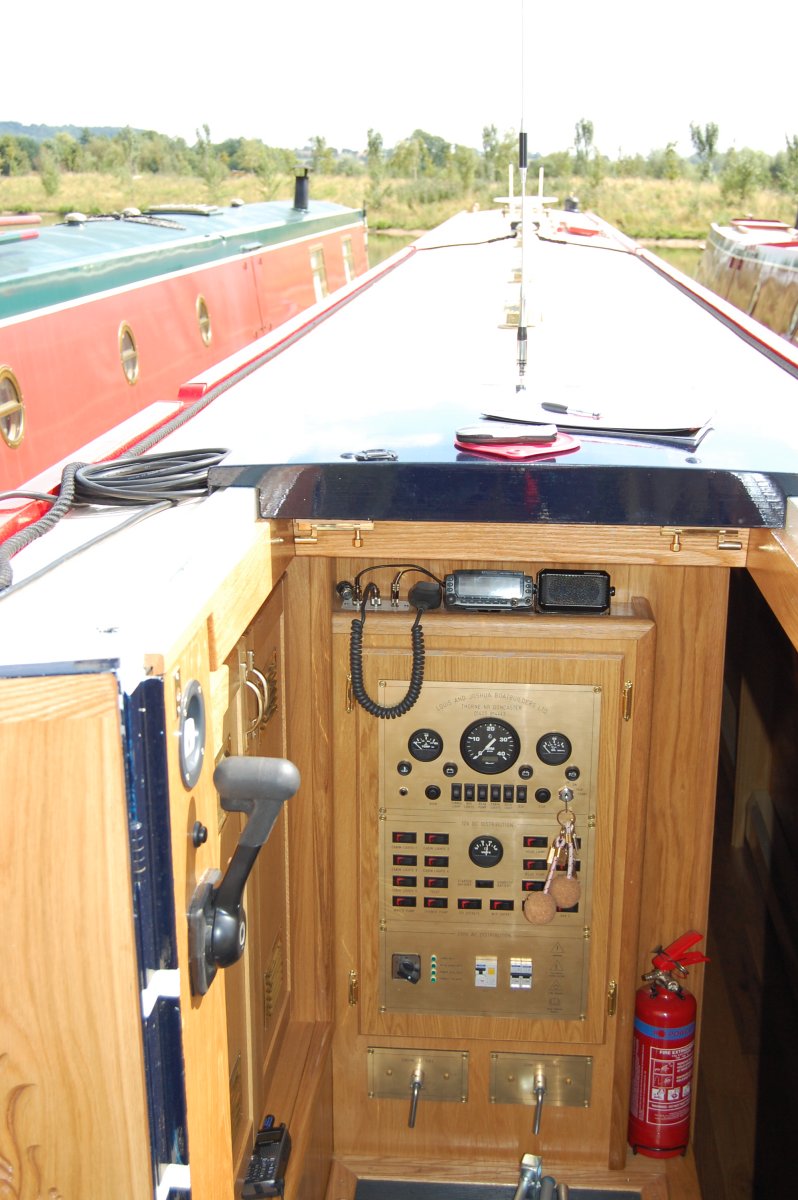 I’m pleased to report that after soldering hundred of connectors last Friday afternoon, the remote head for my marine-style TS-2000 installation worked perfectly, even though we had extended the head by 70 feet (21 meters).
I’m pleased to report that after soldering hundred of connectors last Friday afternoon, the remote head for my marine-style TS-2000 installation worked perfectly, even though we had extended the head by 70 feet (21 meters).














































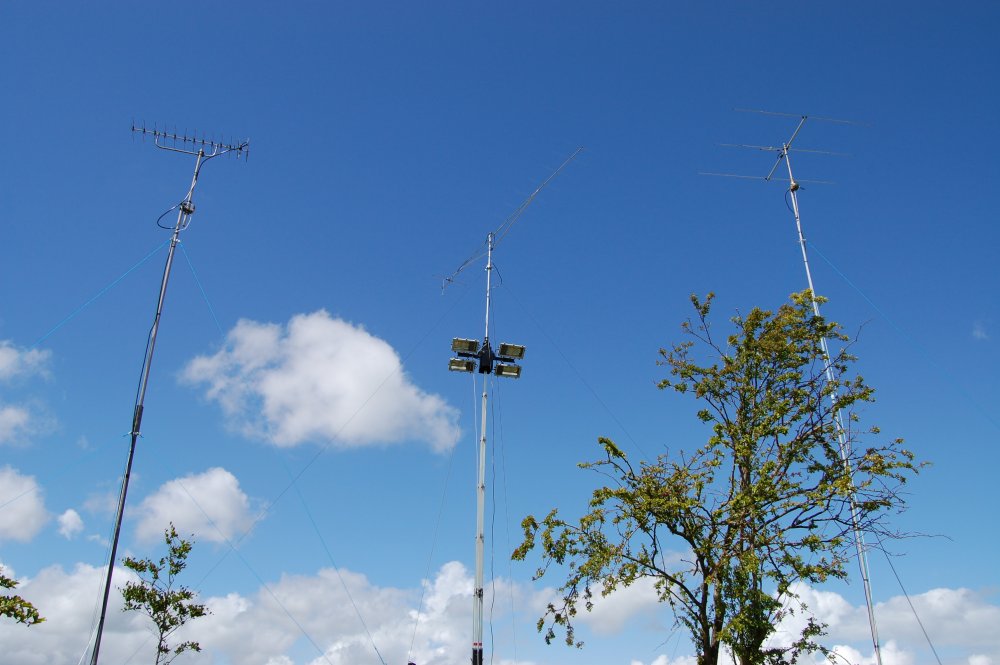 Collectively, we have extremely limited experience with VHF. It came as quite a shock to the system to score so few QSOs relative to HF contests that we enter; we are used to scoring 1,500 contacts in a weekend. I must say that the turn-out felt positively low. Is this really the state of VHF contesting in the UK..?
Collectively, we have extremely limited experience with VHF. It came as quite a shock to the system to score so few QSOs relative to HF contests that we enter; we are used to scoring 1,500 contacts in a weekend. I must say that the turn-out felt positively low. Is this really the state of VHF contesting in the UK..?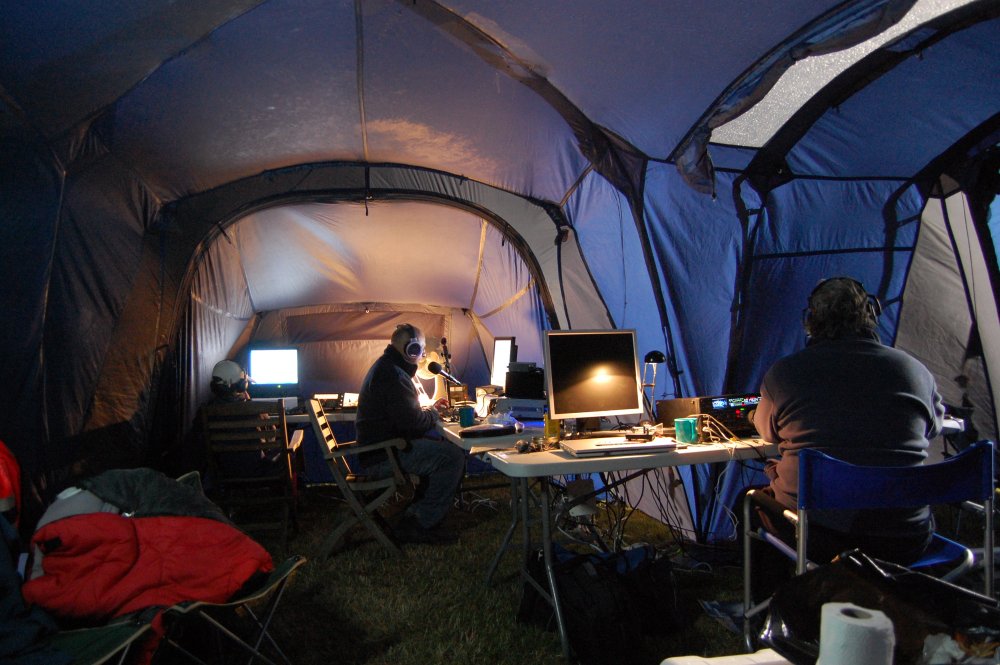
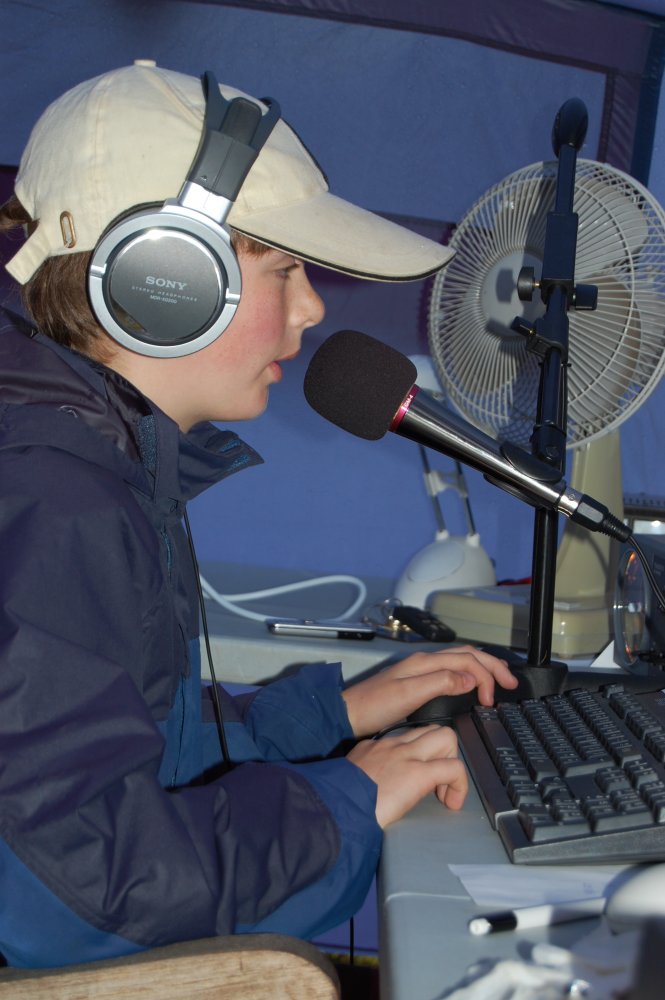
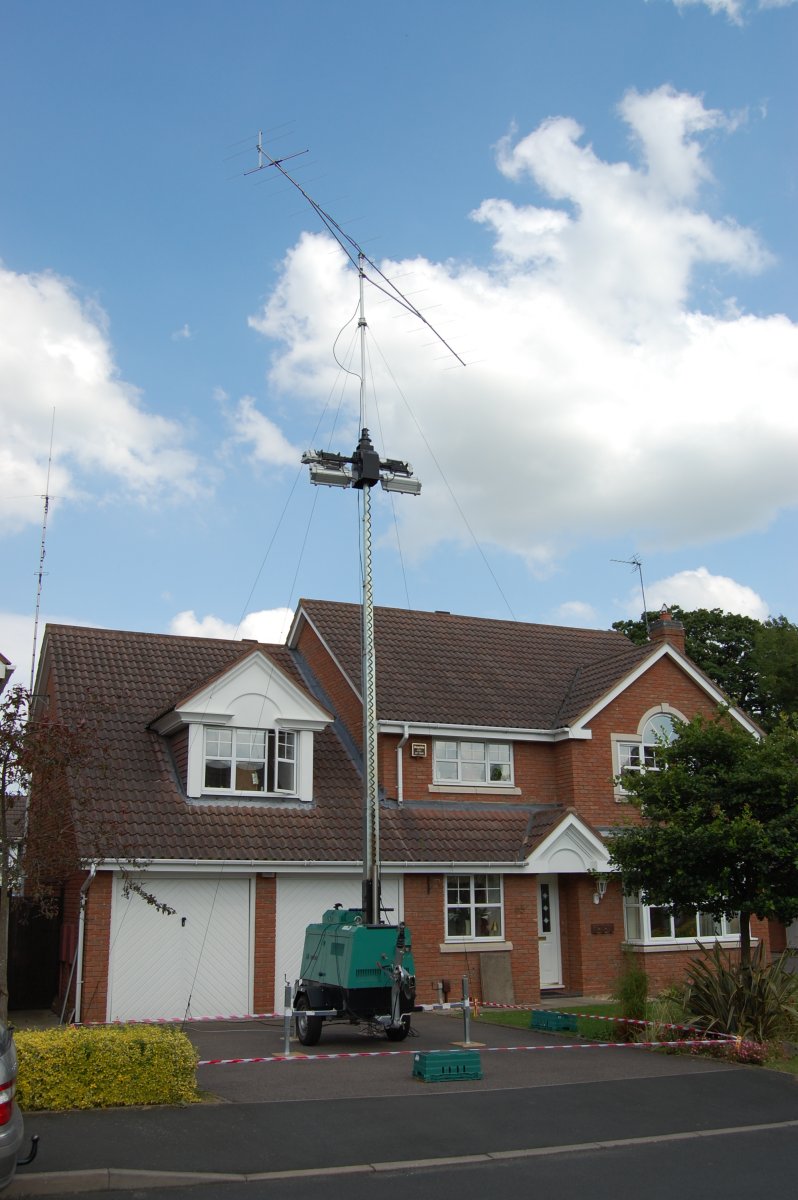 Our 17 element Tonna is up for a test tonight, to ensure that everything will be working for VHF NFD event this weekend. Initial results are proving that its an extremely capable antenna and at 30 feet high, it’s just sitting over the rooftops, giving me a clear run across Warwickshire to the continent.
Our 17 element Tonna is up for a test tonight, to ensure that everything will be working for VHF NFD event this weekend. Initial results are proving that its an extremely capable antenna and at 30 feet high, it’s just sitting over the rooftops, giving me a clear run across Warwickshire to the continent.
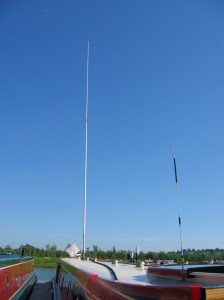 Never one to do things by half, I have finally completed the HF installation on my narrowboat. First impressions are excellent, I believe it’s working very well. I now need a solid state 500 watt linear amplifier to make use of the 800w PEP atu at the feedpoint. Can’t wait.
Never one to do things by half, I have finally completed the HF installation on my narrowboat. First impressions are excellent, I believe it’s working very well. I now need a solid state 500 watt linear amplifier to make use of the 800w PEP atu at the feedpoint. Can’t wait.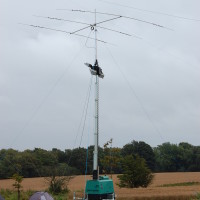 Last night, we finally fitted the rotator housing and G450 Yaesu Rotator to the tower and tested it out with a small VHF ZL Special which we’ll use for VHF NFD in July (being at 1,000 feet means that we might be able to get away without high-gain antenna arrays, time will tell).
Last night, we finally fitted the rotator housing and G450 Yaesu Rotator to the tower and tested it out with a small VHF ZL Special which we’ll use for VHF NFD in July (being at 1,000 feet means that we might be able to get away without high-gain antenna arrays, time will tell).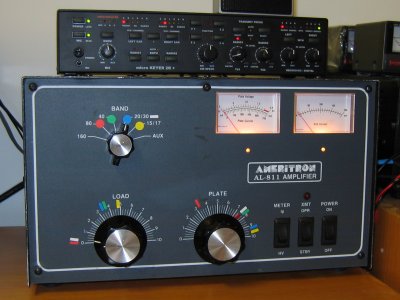 Don’t spend your life tuning amps. Do it once with sticky labels and forget!
Don’t spend your life tuning amps. Do it once with sticky labels and forget!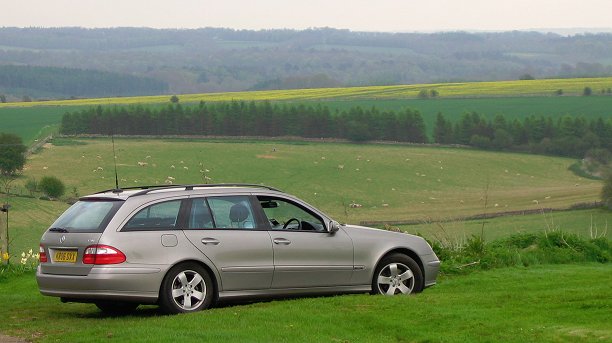
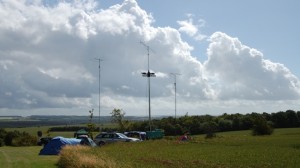
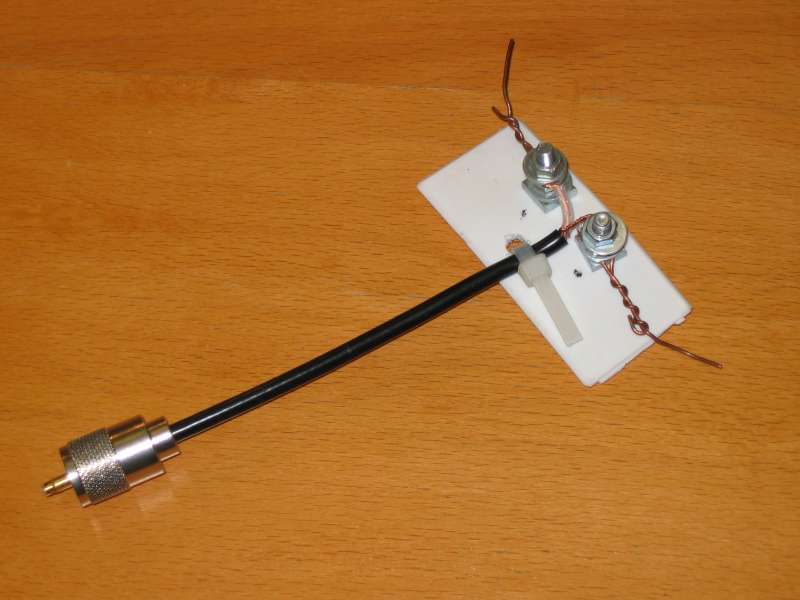 Assuming you have built everything so far to this large scale, you only need to worry about the vertical radiator and then this is just a matter of making a coil. I forget the actual dimensions, I think it ended up at 33 turns on a 2 inch former, using 2.5mm ring mains insulated copper wire (we used the Red portion!) and we put the coil right in the middle of the vertical. It’s an easy matter of raising it, measuring SWR then lowering it again to make adjustments to the coil to finally get a match. I seem to remember that one turn was worth about 40kHz (this moved the SWR from 3.700 to 3.740) but I don’t remember exactly.
Assuming you have built everything so far to this large scale, you only need to worry about the vertical radiator and then this is just a matter of making a coil. I forget the actual dimensions, I think it ended up at 33 turns on a 2 inch former, using 2.5mm ring mains insulated copper wire (we used the Red portion!) and we put the coil right in the middle of the vertical. It’s an easy matter of raising it, measuring SWR then lowering it again to make adjustments to the coil to finally get a match. I seem to remember that one turn was worth about 40kHz (this moved the SWR from 3.700 to 3.740) but I don’t remember exactly.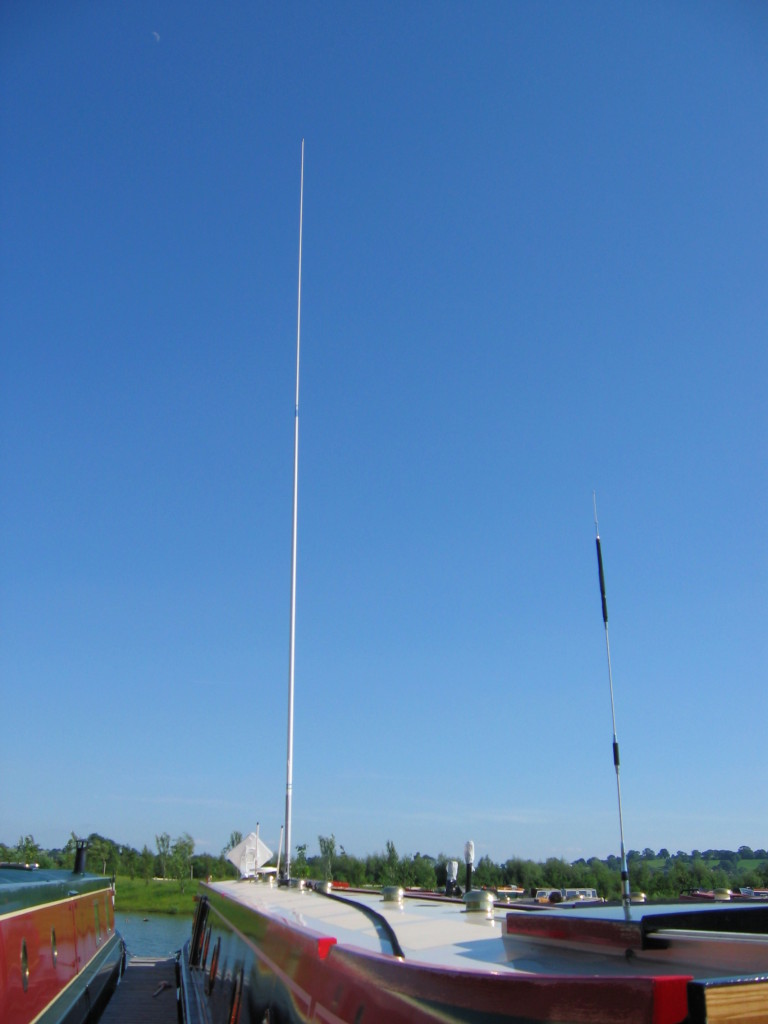
 Wherethehell-Rwe, our new 70 foot, 22 ton narrowboat was launched last week whilst we were in Disneyland. For once I’m actually speachless!
Wherethehell-Rwe, our new 70 foot, 22 ton narrowboat was launched last week whilst we were in Disneyland. For once I’m actually speachless!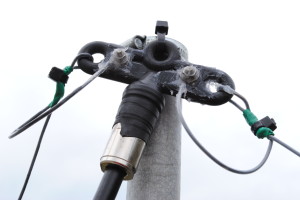 The day itself was excellent; we had a different Brownie pack through the door every half-hour. Each pack would have a fun chat outside by me before watching the “Hello” film from the ARRL. It’s very American but I can’t find anything short and to the point that can replace this wonderful little blast of interest for children. RSGB, if you have something – please let me know since I would love to show something a little more English.
The day itself was excellent; we had a different Brownie pack through the door every half-hour. Each pack would have a fun chat outside by me before watching the “Hello” film from the ARRL. It’s very American but I can’t find anything short and to the point that can replace this wonderful little blast of interest for children. RSGB, if you have something – please let me know since I would love to show something a little more English.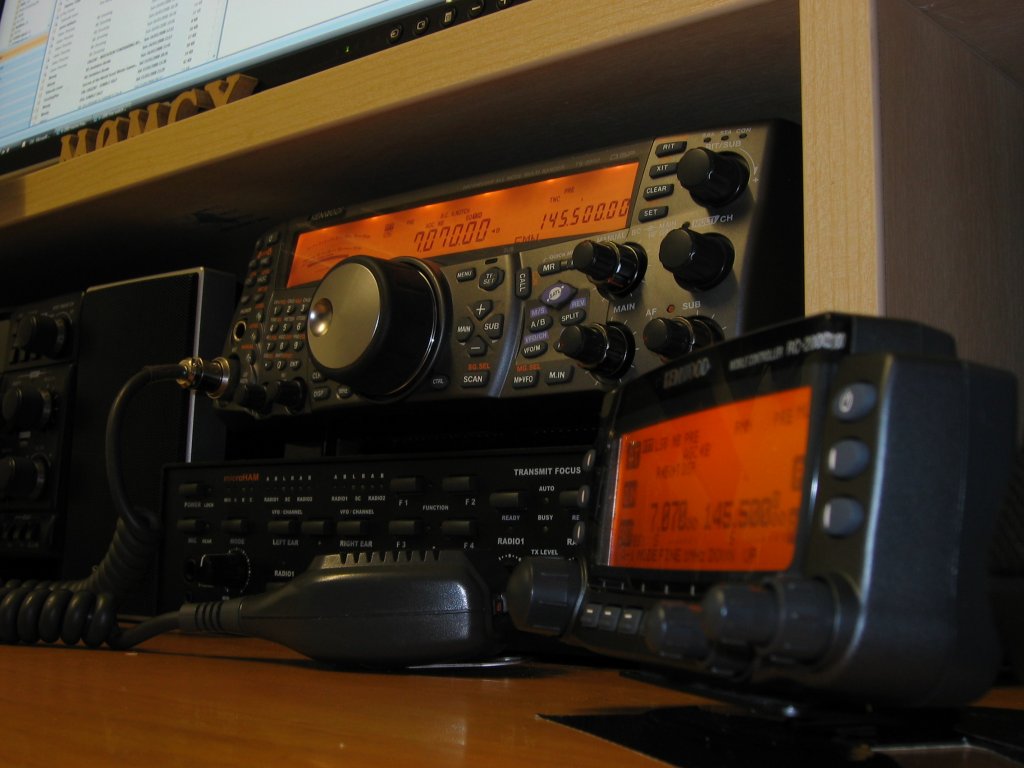 If you’ve been keeping up to date then you’ll know that I have chosen the TS-2000 as the primary radio on board our new narrowboat, “Wherethehell-Rwe”. At the helm (which is a dead give-away for my yachting heritage) I have specified the RC-2000 which should be rather fun to muck about with as I swan along at 3mph across the countryside. In English then, the TS-2000 will sit at the front of the boat near the bow and 60 feet away at the stern (the back.. or in narrowboat terminology, the steering position), I’ll be running an RC-2000 remote controlled head, remote microphone and remote loud speaker. Clearly I’ll also need a switching system up near the front so that I can also use my toys in the evening in the comfort of the boat.
If you’ve been keeping up to date then you’ll know that I have chosen the TS-2000 as the primary radio on board our new narrowboat, “Wherethehell-Rwe”. At the helm (which is a dead give-away for my yachting heritage) I have specified the RC-2000 which should be rather fun to muck about with as I swan along at 3mph across the countryside. In English then, the TS-2000 will sit at the front of the boat near the bow and 60 feet away at the stern (the back.. or in narrowboat terminology, the steering position), I’ll be running an RC-2000 remote controlled head, remote microphone and remote loud speaker. Clearly I’ll also need a switching system up near the front so that I can also use my toys in the evening in the comfort of the boat.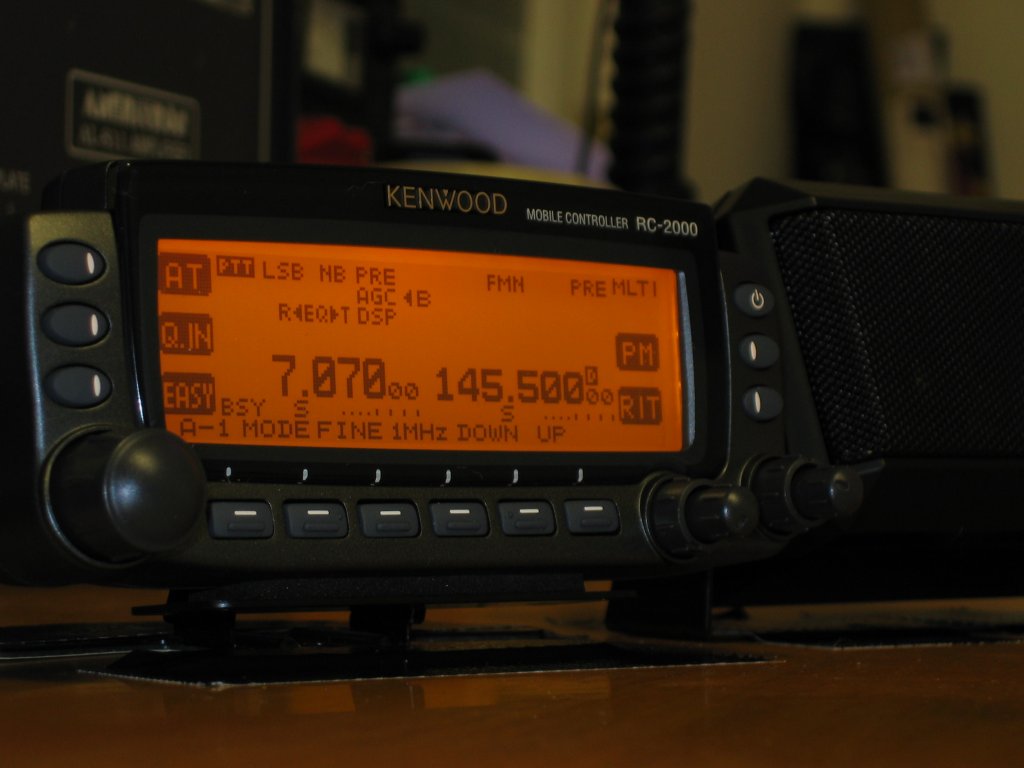
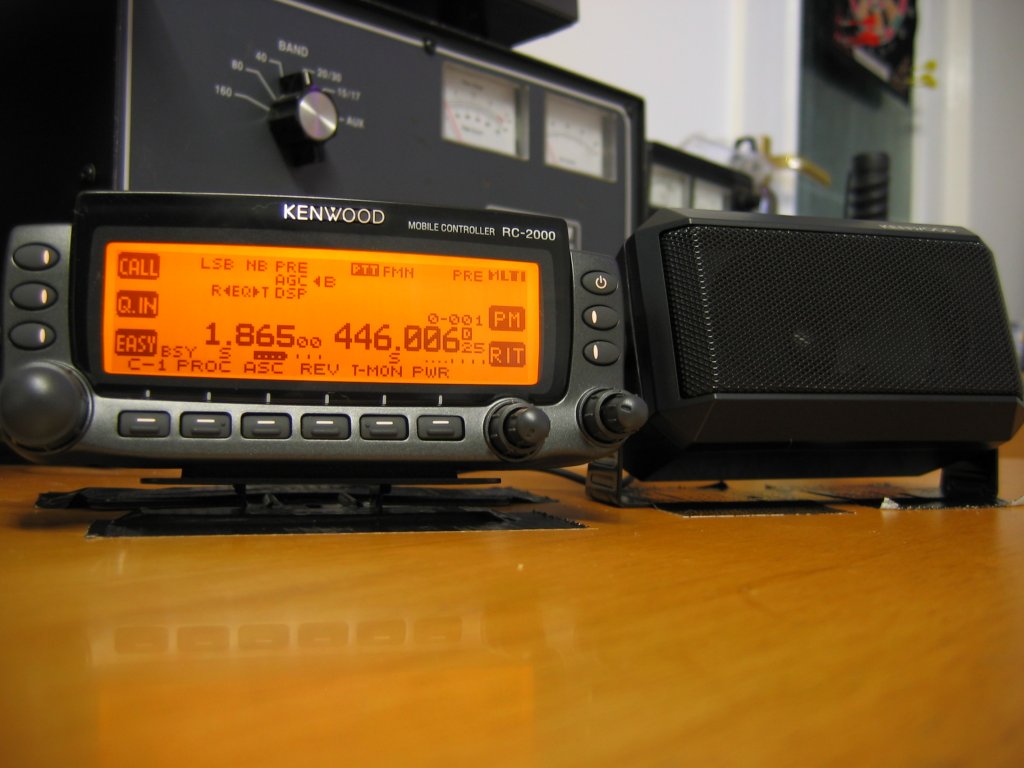

 Five years after becoming licensed, I’ve finally got around to putting a formal station earth / ground in situ comprising 2 x four foot copper rods and a liberal amount of copper wire into the ground on the front lawn. Instead of cutting the last 8 foot off, I used a lawn edger and shoved the copper about 4 inches into the lawn until there was two foot left. Looking around wondering what to do with this, I spotted my massive hammer drill with 24 inch 20mm drill bit. Clearly, it was asking me to drill a hole into the lawn and shove the remainer into it! I did. So I now have 2 x four foot and 1 x 24 inch ground. No idea if this remainder will do any use at all. You never know.
Five years after becoming licensed, I’ve finally got around to putting a formal station earth / ground in situ comprising 2 x four foot copper rods and a liberal amount of copper wire into the ground on the front lawn. Instead of cutting the last 8 foot off, I used a lawn edger and shoved the copper about 4 inches into the lawn until there was two foot left. Looking around wondering what to do with this, I spotted my massive hammer drill with 24 inch 20mm drill bit. Clearly, it was asking me to drill a hole into the lawn and shove the remainer into it! I did. So I now have 2 x four foot and 1 x 24 inch ground. No idea if this remainder will do any use at all. You never know.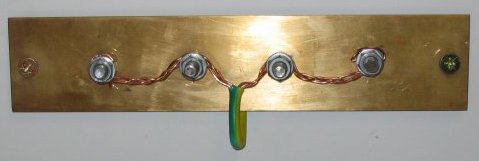
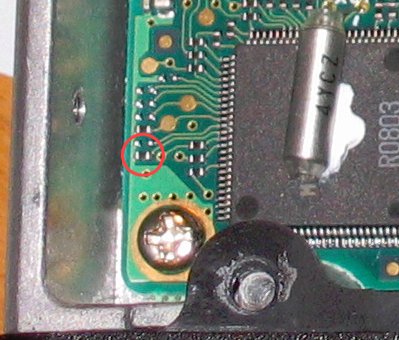 Ideally, you need 12.5 kHz channel selection starting from 446.006.25 which all Kenwood’s do (eg TS-2000 and Kenwood handies) however I don’t believe there’s a way to do this with FM only Yaesu Ham rigs.
Ideally, you need 12.5 kHz channel selection starting from 446.006.25 which all Kenwood’s do (eg TS-2000 and Kenwood handies) however I don’t believe there’s a way to do this with FM only Yaesu Ham rigs.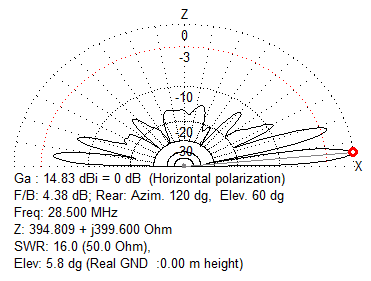 Apart from the noise factor (loops are quiet), the vertical seems to make a better impact on transmit more often than not for DX, unless I’m into NVIS or near NVIS (500 miles or so). Even then, up to 1,500 miles, the jury is out – either antenna can win. Beyond 1,500 miles the vertical seems to do a better job most of the time – not always, however my loops are very low to the ground, maximum height of 7 meters. On 40m, I would say the vertical is a better antenna to have almost all of the time unless you need NVIS for local copying – and with the sun spot cycle as it is, you won’t get this for a while yet!
Apart from the noise factor (loops are quiet), the vertical seems to make a better impact on transmit more often than not for DX, unless I’m into NVIS or near NVIS (500 miles or so). Even then, up to 1,500 miles, the jury is out – either antenna can win. Beyond 1,500 miles the vertical seems to do a better job most of the time – not always, however my loops are very low to the ground, maximum height of 7 meters. On 40m, I would say the vertical is a better antenna to have almost all of the time unless you need NVIS for local copying – and with the sun spot cycle as it is, you won’t get this for a while yet!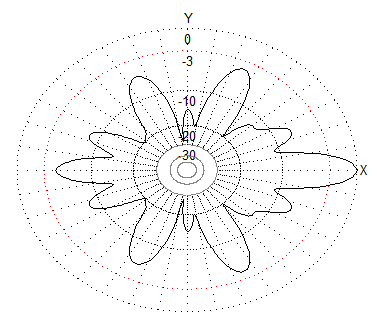 Now.. This is a very different animal to the Skyloops that most people build. If you want a pile-up generator, this is the animal to have. It fundamentally, takes all your RF energy and pancakes it low to the ground in various star shapes. Very Of course, you will sometimes null out the station you want but you could get really clever and change feedpoints with relays. But ignoring the clever engineering, this has changed my mind as to the effectiveness of a high skyloop.
Now.. This is a very different animal to the Skyloops that most people build. If you want a pile-up generator, this is the animal to have. It fundamentally, takes all your RF energy and pancakes it low to the ground in various star shapes. Very Of course, you will sometimes null out the station you want but you could get really clever and change feedpoints with relays. But ignoring the clever engineering, this has changed my mind as to the effectiveness of a high skyloop.